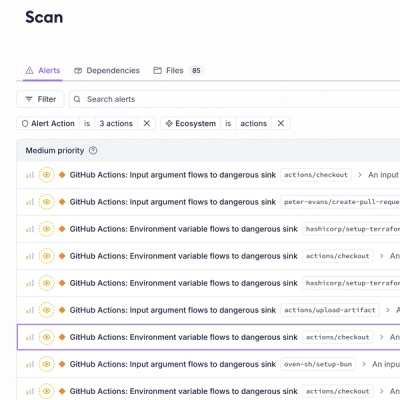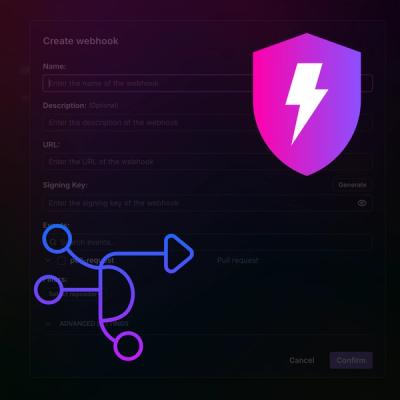
Product
Introducing GitHub Actions Scanning Support
Detect malware, unsafe data flows, and license issues in GitHub Actions with Socket’s new workflow scanning support.
ember-cli-cedar
Advanced tools
Ember addon for the @esri/cedar charting library.
This addon exposes the {{cedar-chart}} component that you can use to declaratively add a Cedar chart to your ember application.
{{!-- you can pass the definition as an object --}}
{{cedar-chart
definition=model
onError=(action 'showError')
}}
{{!-- or you can pass the individual parts of a definition --}}
{{cedar-chart
type=model.type
datasets=model.datasets
series=model.series
overrides=model.overrides
legend=model.legend
style=model.style
onError=(action 'showError')
}}
NOTE: if you've configured emeber-cli-cedar to lazy-load cedar dependencies, then the {{cedar-chart}} component will handle that for you.
This addon exposes the cedar-loader service that you can use to control when cedar's dependencies are lazy-loaded (if you've configured ember-cli-cedar to do so). This can be useful if you want to implement your own chart component instead of using {{cedar-chart}}. The service exposes a single function loadDependencies() which returns a Promise that will resolve with the cedar global once the dependencies have been loaded.
this.get('cedarLoader').loadDependencies().then(cedar => {
// now you can safely use cedar
this.chart = new cedar.Chart(this.elementId, definition);
});
Alternatively you can import from the cedar library directly:
import { Chart } from '@esri/cedar';
this.chart = new Chart(this.elementId, definition);
NOTE: If you will be lazy-loading cedar's dependencies, you should probably use the service instead.
Below are the instructions for using v0.x.
This addon exposes a component you can use to declaratively add a Cedar chart to your ember application:
{{cedar-chart
type="bar"
datasets=model.datasets
series=model.series
specification=model.specification
timeout=5000
options=model.options
override=model.override
onUpdateStart=(action 'onChartUpdateStart')
onUpdateEnd=(action 'onChartUpdateEnd')
onError=(action 'onChartError')
transform=(action chartTransform')
}}
See the Cedar documentation for details on how to construct a chart definition and other chart parameters.
To consume this addon in any ember application, run:
ember install ember-cli-cedar
Please see the Dependencies and Configuration sections below for further installation steps.
This addon will add @esri/cedar as a dependency to your application.
@esri/cedar depends on amCharts, which will be installed locally as an npm dependency. However, you have a few options as to how your application will load amCharts' scripts, styles, themes, and/or plugins. You can either:
<script> and <link> tagsThe ideal way to load amCharts is only once a cedar chart is going to be rendered. You can configure ember-cli-cedar to lazy-load amCharts files either from a CDN, or from locally served files.
The easiest way to lazy-load AmCharts is to configure an array of the amCharts dependencies that your application needs along with an optional baseUrl like this in config/environment.js:
// config/environment.js
let ENV = {
cedar: {
amCharts: {
// baseUrl: the base URL to use for any relative dependencies below
// if baseUrl is not defined then it will use window.AmCharts_path
// here we'll load the dependencies below from amCharts' own CDN
baseUrl: 'https://www.amcharts.com/lib/3'
// dependencies - the amCharts resources that your application needs
// these will be lazy-loaded the first that the application either
// - renders a {{cedar-chart}} component
// - calls this.get('cedarLoader').loadDependencies()
dependencies: [
// amCharts base lib, this one is required and MUST be the first element in the array
'amcharts.js',
// you will likely need at least one of the following:
'serial.js', // bar and line charts
'xy.js', // scatter charts
'pie.js', // pie and donut charts
'radar.js', // radar charts
// you will also likely need a theme to style charts
// in this case we want to use cedar's calcite theme
// so we use a fully qualified URL since it is not hosted at the above baseUrl
// 'https://unpkg.com/@esri/cedar@1.0.0-beta.9/dist/umd/themes/amCharts/calcite.js',
// plugins are complely optioinal
// this one adds a download button on the chart
'plugins/export/export.js',
'plugins/export/export.css'
]
}
}
}
Alternatively, you can lazy-load locally installed copy of amCharts from the public folder.
First, configure ember-cli-cedar to serve the locally installed copy of amCharts.
Next you will need to modify the cedar.amCharts settings in enviroment/config.js (above) by:
baseUrl'themes/calcite.js'NOTE: you do not need to set the baseUrl in this case, since the cedar loader service will default to window.AmCharts_path, which is automatically set in contentFor('head') to the publicPath you configured in ember-cli-build.js.
This addon's dummy app is configured to lazy-load from the public folder, so you can look at ember-cli-build.js tests/dummy/config/environment.js for an example of this kind of configuration.
Instead of lazy-loading, you can configure ember-cli-cedar to import the amCharts dependencies into vendor.js and vendor.css.
First, configure ember-cli-cedar to serve the locally installed copy of amCharts.
Next, instead of adding the cedar.amCharts settings to config/enviroment.js (above), add the following list of imports to the cedar.amCharts section that you just added to ember-cli-build.js (i.e. right below publicPath) :
// ember-cli-build.js
imports: [
// amCharts base lib, this one is required and MUST be the first element in the array
'amcharts.js',
// you will likely need at least one of the following:
'serial.js', // bar and line charts
'xy.js', // scatter charts
'pie.js', // pie and donut charts
'radar.js', // radar charts
// you will also likely need a theme to style charts
'themes/calcite.js',
// plugins are complely optioinal
// this one adds a download button on the chart
'plugins/export/export.js',
'plugins/export/export.css'
]
NOTE: the above imports goes in ember-cli-build.js, and should not be confused with the dependencies array that goes in config/enviroment.js.
To load amCharts from a CDN, you can skip all of the above configuration steps and simply add <script> and/or <link> tags for the amCharts dependencies to your index.html before the vendor.js script:
<!-- load the amCharts base library -->
<script src="https://www.amcharts.com/lib/3/amcharts.js"></script>
<!-- for bar, line, and area charts -->
<script src="https://www.amcharts.com/lib/3/serial.js"></script>
<!-- for pie charts -->
<script src="https://www.amcharts.com/lib/3/pie.js"></script>
<!-- for scatter and bubble charts -->
<script src="https://www.amcharts.com/lib/3/xy.js"></script>
<!-- for radar charts -->
<script src="https://www.amcharts.com/lib/3/radar.js"></script>
<!-- optionally load an amcharts theme -->
<!-- cedar provides a calcite theme -->
<script src="https://unpkg.com/@esri/cedar/dist/umd/themes/amCharts/calcite.js"></script>
<!-- or you could use one of the themes from amcharts -->
<!-- <script src="https://www.amcharts.com/lib/3/themes/light.js"></script> -->
<!-- optioinally load the amcharts plugin to export the chart as and image or table -->
<script src="https://www.amcharts.com/lib/3/plugins/export/export.min.js"></script>
<link rel="stylesheet" href="https://www.amcharts.com/lib/3/plugins/export/export.css" type="text/css" media="all" />
<script src="{{rootURL}}assets/vendor.js"></script>
If you want to serve the amCharts package that is installed locally (in node_modules), you will need to start by adding the following options in ember-cli-build.js:
// ember-cli-build.js
{
cedar: {
amCharts: {
// publicPath - amCharts will be included at this path in the public folder
// use this if you are goint to either:
// - import amcharts into vendor files
// - or lazy-load amcharts from the public folder
publicPath: 'amcharts'
}
}
// amCharts uses hardcoded paths to assets (like images and plugin files)
// so you will need to make sure those don't get fingerprinted
fingerprint: {
// NOTE: this needs to be the same as publicPath above
exclude: ['amcharts']
}
}
If you're serving the locally installed amCharts files, we assume that your assets are hosted under your application's rootURL and the publicPath is relative to that location. However, if for certain environments you deploy your assets to a remote CDN (i.e. using an addon like ember-cli-deploy-cloudfront), you will also need to specify the assetBaseUrl in config/enviroment.js.
// config/enviroment.js
if (environment === 'production') {
// tell amCharts to look for scripts, styles, themes, and assets at the CDN
ENV.cedar.amCharts.assetBaseUrl = 'https://fa9efa977faw99.cloudfront.net/my-app/assets'
}
NOTE: window.AmCharts_path will be set to ENV.cedar.amCharts.assetBaseUrl concatenated with the publicPath.
After cloning the repository you can test this addon in the dummy app with:
ember serverNOTE: Windows users may need to specify an alternate livereload port like:
ember server -lrp 9000
In the root of this repo run:
npm link
In the consuming app, run:
npm link ember-cli-cedar
ember generate ember-cli-cedar
ember server
npm test (Runs ember try:testall to test your addon against multiple Ember versions)ember testember test --serverember buildFor more information on using ember-cli, visit https://ember-cli.com/.
Esri welcomes contributions from anyone and everyone. Please see our guidelines for contributing.
Copyright © 2016-2018 Esri
Licensed under the Apache License, Version 2.0 (the "License"); you may not use this file except in compliance with the License. You may obtain a copy of the License at
Unless required by applicable law or agreed to in writing, software distributed under the License is distributed on an "AS IS" BASIS, WITHOUT WARRANTIES OR CONDITIONS OF ANY KIND, either express or implied. See the License for the specific language governing permissions and limitations under the License.
A copy of the license is available in the repository's LICENSE file.
FAQs
Ember addon for Esri Cedar charting library
The npm package ember-cli-cedar receives a total of 444 weekly downloads. As such, ember-cli-cedar popularity was classified as not popular.
We found that ember-cli-cedar demonstrated a not healthy version release cadence and project activity because the last version was released a year ago. It has 5 open source maintainers collaborating on the project.
Did you know?

Socket for GitHub automatically highlights issues in each pull request and monitors the health of all your open source dependencies. Discover the contents of your packages and block harmful activity before you install or update your dependencies.

Product
Detect malware, unsafe data flows, and license issues in GitHub Actions with Socket’s new workflow scanning support.

Product
Add real-time Socket webhook events to your workflows to automatically receive pull request scan results and security alerts in real time.

Research
The Socket Threat Research Team uncovered malicious NuGet packages typosquatting the popular Nethereum project to steal wallet keys.